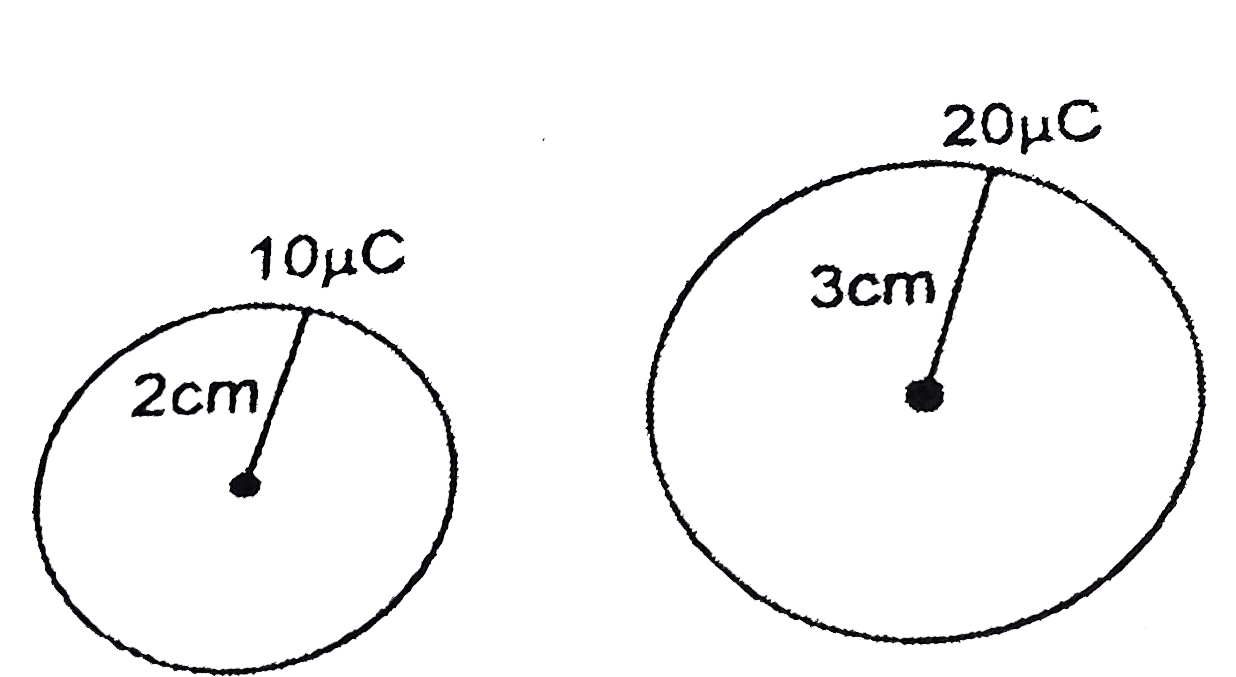Two conducting spheres of radii 6km and 12km each, having the same charge 3×10−8C, are kept very far apart. If the spheres are connected to each other by a conductiong wire, find
i. the direction and amount of charge transferred and
ii. final potential each sphere.
To solve the problem step by step, we will analyze the situation involving the two conducting spheres and calculate the required values.
Step 1: Identify the initial conditions
We have two conducting spheres:
- Sphere 1 (radius r1=6km=6000m)
- Sphere 2 (radius r2=12km=12000m)
Both spheres have the same charge:
- Charge Q1=Q2=3×10−8C
Step 2: Calculate the initial potentials
The potential V of a conducting sphere is given by:
V=Q4πϵ0r
Where ϵ0 is the permittivity of free space, approximately 8.85×10−12C2/N m2.
Calculating the potentials:
- For Sphere 1:
V1=Q14πϵ0r1=3×10−84π(8.85×10−12)(6000)
- For Sphere 2:
V2=Q24πϵ0r2=3×10−84π(8.85×10−12)(12000)
Step 3: Compare the potentials
Since r1<r2, it follows that V1>V2. Therefore, charge will flow from Sphere 1 to Sphere 2 when they are connected by a conducting wire.
Step 4: Calculate the final charges after connecting the spheres
When the spheres are connected, the total charge Q is conserved:
Q=Q1+Q2=3×10−8+3×10−8=6×10−8C
The final charges Q′1 and Q′2 will distribute according to the ratio of their radii:
Q′1=r1r1+r2Q
Q′2=r2r1+r2Q
Substituting the values:
Q′1=60006000+12000⋅6×10−8=600018000⋅6×10−8=13⋅6×10−8=2×10−8C
Q′2=120006000+12000⋅6×10−8=1200018000⋅6×10−8=23⋅6×10−8=4×10−8C
Step 5: Calculate the amount of charge transferred
The charge transferred from Sphere 1 to Sphere 2 is:
ΔQ=Q1−Q′1=3×10−8−2×10−8=1×10−8C
Step 6: Calculate the final potentials
The final potentials can be calculated using the new charges:
V′1=Q′14πϵ0r1
V′2=Q′24πϵ0r2
Substituting the values:
V′1=2×10−84π(8.85×10−12)(6000)
V′2=4×10−84π(8.85×10−12)(12000)
Conclusion
1. Direction and amount of charge transferred: Charge flows from Sphere 1 to Sphere 2, with an amount of 1×10−8C transferred.
2. Final potential of each sphere: Both spheres will have the same final potential, which can be calculated using the final charges.
We have two conducting spheres:
- Sphere 1 (radius r1=6km=6000m)
- Sphere 2 (radius r2=12km=12000m)
- Charge Q1=Q2=3×10−8C
The potential V of a conducting sphere is given by:
V=Q4πϵ0r
Where ϵ0 is the permittivity of free space, approximately 8.85×10−12C2/N m2.
- For Sphere 1:
V1=Q14πϵ0r1=3×10−84π(8.85×10−12)(6000)
V2=Q24πϵ0r2=3×10−84π(8.85×10−12)(12000)
Since r1<r2, it follows that V1>V2. Therefore, charge will flow from Sphere 1 to Sphere 2 when they are connected by a conducting wire.
When the spheres are connected, the total charge Q is conserved:
Q=Q1+Q2=3×10−8+3×10−8=6×10−8C
Q′1=r1r1+r2Q
Q′2=r2r1+r2Q
Q′1=60006000+12000⋅6×10−8=600018000⋅6×10−8=13⋅6×10−8=2×10−8C
Q′2=120006000+12000⋅6×10−8=1200018000⋅6×10−8=23⋅6×10−8=4×10−8C
The charge transferred from Sphere 1 to Sphere 2 is:
ΔQ=Q1−Q′1=3×10−8−2×10−8=1×10−8C
The final potentials can be calculated using the new charges:
V′1=Q′14πϵ0r1
V′2=Q′24πϵ0r2
V′1=2×10−84π(8.85×10−12)(6000)
V′2=4×10−84π(8.85×10−12)(12000)
1. Direction and amount of charge transferred: Charge flows from Sphere 1 to Sphere 2, with an amount of 1×10−8C transferred.
2. Final potential of each sphere: Both spheres will have the same final potential, which can be calculated using the final charges.
Topper's Solved these Questions
- BOOK - CENGAGE PHYSICS ENGLISHCHAPTER - CAPACITOR AND CAPACITANCEEXERCISE - Solved Examples10videos
CAPACITOR AND CAPACITANCE
- BOOK - CENGAGE PHYSICS ENGLISHCHAPTER - CAPACITOR AND CAPACITANCEEXERCISE - Exercise 4.113videos
CAPACITOR AND CAPACITANCE
- BOOK - CENGAGE PHYSICS ENGLISHCHAPTER - ATOMIC PHYSICSEXERCISE - ddp.4.315videos
ATOMIC PHYSICS
- BOOK - CENGAGE PHYSICS ENGLISHCHAPTER - CENGAGE PHYSICS DPPEXERCISE - subjective type51videos
CENGAGE PHYSICS DPP
Similar Questions
Two metallic spheres of radii 1cm and 2cm are given charges 10−2C and 5×10−2C respectively. If they are connected by a conducting wire, the final charge on the smaller sphere is
View SolutionTwo conducting spheres of radii r and 2r are placed at very large separation. Each sphere possesses charge Q. These spheres are connected with a conducting wire of resistance R. Then, which of the following is true?
View SolutionTwo conducting spheres of radii 3 cm and 1 m are separated by a distance of 10 cm in free space. If the spheres are charged to same potential of 10 V each, then the force of repulsion between them is
View SolutionFigure shows two conducting spheres separated by large distance and of radius 2 cm and 3 cm containing charges 10μC and 20μC respectively. When the spheres are connected by a conducting wire then find out following :
(i) Ratio of the final charge.
(ii) Final charge on each sphere.
(iii) Ratio of final charge densities.
(iv) Heat produced during the process.
 View Solution
View SolutionTwo metal spheres A and B of radii a & b (a < b) respectively are at a large distance apart. Each sphere carries a charge of 100μO. the sphere are connected by a conducting wire, then
View SolutionTwo insulated charged conducting spheres of radii 20cm and 15cm respectively and having an equal charge of 10C are connected by a copper wire and then they are separted. Then
View SolutionTwo isolated metallic solid spheres of radii R and 2R are charged such that both of these have same charge density σ. The spheres are located far away from each other and connected by a thin conducting wire. Find the new charge density on the bigger sphere.
View SolutionTwo concentric hollow conducting spheres of radius a and b (b>a) contains charges Qa and Qb respectively. If they are connected by a conducting wire then find out following
(i) Final charges on inner and outer spheres.
(ii) Heat produced during the process.View SolutionTwo spheres of same metal have radii a and b . They have been connected to a conducting wire. Find the ratio of the electric field intensity upon them.
View SolutionAnswer the following:
(i) If two similar large plates, each of area A having surface charge densities +σ and −σ are separated by a distance d in air,find the expression for
(a) field at points between the two plates and on outer side of the plates. Specify the direction of the field in each case.
(b) the potential difference between the plates.
(c) the capacitance of the capacitor so formed.
(ii) Two metallic spheres of radii R and 2R are charged so that both of these have same surface charge density σ. If they are connected to each other with a conducting wire, in which direction will the charge flow and why ?View Solution

